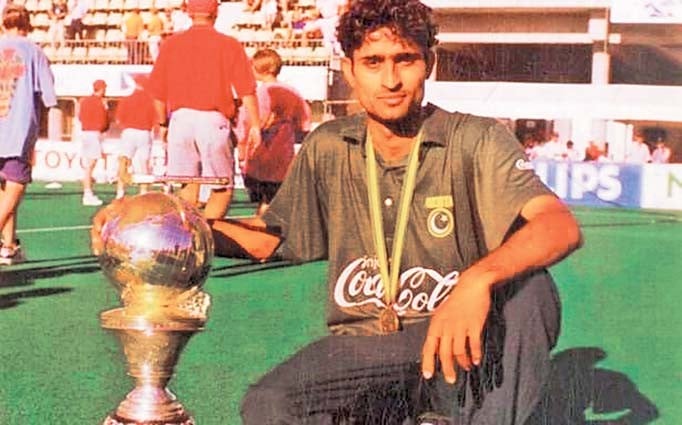
There was a time when Pakistani hockey players gained stardom with one or two match-winning performances in major international events

For the first World Cup in 1971, Pakistan’s selection committee’s proposed team included full-backs, Tanveer Dar, Akhtar-ul-Islam and Najmi. The list was sent to the executive council of Pakistan Hockey Federation for approval, an exercise generally regarded a formality. But the council surprisingly replaced Najmi with 19-year-old novice Munawwar-uz Zaman.
Munawwar went to Spain as the reserve full-back. As luck would have it, Pakistan’s regular fullback Akhtarul Islam was debarred for two matches. Munawwar made his internationals debut in the last pool match. Lady luck again smiled on Munawwar in the next match--the semi-final against archrivals India. Pakistan’s legendary penalty corner striker Tanvir Dar had been in tremendous form during that World Cup.
Tanvir had scored as many as eight out of Pakistan’s 11 goals in the pool matches. In the semi-final, with the score tied at 1-1, Tanvir Dar injured his knee and limped out of the match. Shortly afterwards, Pakistan were awarded a penalty corner. Munawwar was asked to take the strike.
It was Munawwar’s first attempt at penalty corner in an international match. It was a World Cup semi-final and that too against India.
The teenager stepped up and sounded the board to score the winning goal. Pakistan went on to win the World Cup and Munawwar became a household name in Pakistan.
In Pakistan’s next World Cup triumph in 1978, almost a similar story surfaced. Just before the World Cup, Pakistan and India played a four-Test series. In the last test, Pakistan’s legendary right full back Manzoorul Hassan suffered a fracture in the arm. For the World Cup, Rana Ehsanullah replaced Manzoor.
Ehsan had only made a tour of Kenya in 1974 with the Pakistan Whites team. He made his full international debut in the 1978 World Cup itself and scored in the very first match. But he was destined to gain eternal fame later.
In the final against Holland, the score was tied 2-2 till late in the second half. Pakistan’s first choice penalty corner expert Munawwar-uz Zaman had not been able to convert any of the penalty corners that came Pakistan’s way. When the next penalty corner arrived, skipper Islahuddin signaled Ehsan to move up. And as they say, the rest is history; Ehsan scored the World Cup winning goal.
In Pakistan’s next World Cup victory in 1982, yet another rookie attained instant stardom. The 17-year-old goalkeeper Shahid Ali Khan went to Bombay (now Mumbai) as the reserve to the experienced Moinuddin. Prior to the World Cup, Shahid had experience of just one international, a test match against the touring Zimbabwe. With Pakistan’s semi-final berth already secured, Shahid was included in the last pool match against Poland, only his second international.
Pakistan’s next game was the semi-final against Holland. When the names of the two teams flashed on the television screens before the semi-final, many viewers thought some mistake had occurred. But there was no mistake. Pakistan’s manager Brigadier MH Atif had included Shahid in place of Moinuddin.
Atif contended that since Moinuddin had been beaten three times on penalty corners during Pakistan’s toughest pool match, against Germany which Pakistan won 5-3, his (Moin’s) confidence was badly shaken.
Teenaged Shahid stunned everyone in the semi-final. During the early stages of the game, Holland were awarded a penalty stroke.
The penalty stroke was taken by the Dutch hockey legend Ties Kruize. Shahid acrobatically saved the goal. The buoyed up Pakistan team went on to win the match easily 4-2. Then, in Pakistan’s victory in the final, the young Shahid again guarded Pakistan’s net.
It is worth mentioning that before that semi-final, Kruize had attempted more than 40 penalty strokes in international hockey and had never failed.
Paupers in 1986; Kings in 1994
Pakistan won back-to-back World Cups in 1978 and 1982 without losing or even drawing a single match. How did they perform in the very next World Cup? Pakistan contested for the wooden spoon.
Yes, they played against India (the winners of the 1975 World Cup) for the 11th and 12th position which Pakistan won.
Pakistan were able to make immediate recovery from this abysmal depth. They finished second and first in the next two World Cups, in 1990 and 1994 respectively.
It is interesting to know that the only two surviving players from the 1986 debacle emerged as Pakistan’s greatest heroes in the victory march of 1994 World Cup. Mercurial forward Shahbaz Ahmad not only captained Pakistan in 1994 but was also named the Player of the Tournament.
Goalkeeper Mansoor Ahmad’s (vice-captain) brilliance carried Pakistan through penalty shootouts, in the semi-final as well as the final. He was also named the best goalkeeper of the World Cup.
ijaz62@hotmail.com